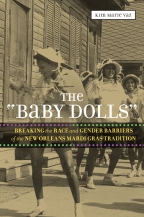
200 pages / 6.12 x 9.25 inches / 37 halftones
Social Studies / Cultural Anthropology | Social Studies / Women's Studies | Social Studies / Regional Studies | Women's Studies
One of the first women’s organizations to mask and perform during Mardi Gras, the Million Dollar Baby Dolls redefined the New Orleans carnival tradition. Tracing their origins from Storyville-era brothels and dance halls to their re-emergence in post-Katrina New Orleans, author Kim Marie Vaz uncovers the fascinating history of the “raddy-walking, shake-dancing, cigar-smoking, money-flinging” ladies who strutted their way into a predominantly male establishment.
Kim Marie Vaz is the associate dean of the College of Arts and Sciences and professor of education at Xavier University of Louisiana. Her area of research is the use of expressive arts as a response to large-group social trauma.
“The book is an important scholarly effort for the history of not only women of color but also all women in the Bayou State and beyond. The anecdotal supplemented with the theoretical helps readers to think through complicated notions of the identity performances of these women.”—Journal of Southern History
“Kim Vaz’s engaging and thoroughly researched book is the first in-depth study of one of New Orleans’s least understood Mardi Gras performances. . . . Vaz offers compelling new perspectives on Baby Doll history, the maskers themselves, and their refusal to be defined by cultural stereotypes. Most importantly, she allows us to hear the formerly silenced voices of the women at the heart of the Baby Doll tradition.”—Carolyn Ware, coauthor of Cajun Mardi Gras Masks
“Vaz provides a fascinating glance into the Mardi Gras masking tradition through the lives of those who were most marginalized. . . . Highly recommended.”—Choice
Video: Steppin' Out (WYES)
Audio: Vaz talks about the African American heritage of Mardi Gras on the Jim Engster Show
Audio: The 'Baby Dolls' Of Mardi Gras: A Fun Tradition With A Serious Side (NPR Weekend Edition)
Audio: Vaz discusses her book with Susan Larson, host of The Reading Life (WWNO)
Audio: Tom Joyner presents Little Known Black History Fact: Baby Dolls
Review: They Call Me Baby Doll (Gambit)
Dixie, ‘Baby Dolls’ explore New Orleans subjects (The Advocate)
Exhibit spotlights gaudy celebration of women in Carnival (The Advocate)
Barrier-breaking Baby Dolls (Ms. blog)
Revealed: The fascinating (and seedy) roots of the traditional Baby Dolls of Mardi Gras (Daily Mail UK)
African-American baby doll tradition is undergoing a revival in New Orleans for Mardi Gras (The Washington Post)
Mardi Gras Baby Doll maskers bring joy to Louisiana State Museum (The Times-Picayune)
Little Known Black History Fact: Baby Dolls (Black America)
Baby Dolls instigate Carnival fun (Tulane New Wave)
Baby Dolls shaped Mardi Gras and jazz in NOLA (The News Star)
Subverting the Status Quo (New Orleans Living)
Museum exhibit listing
More information about the exhibit
Learn more about the tradition at TheyCallMeBabyDoll.org
Found an Error? Tell us about it.